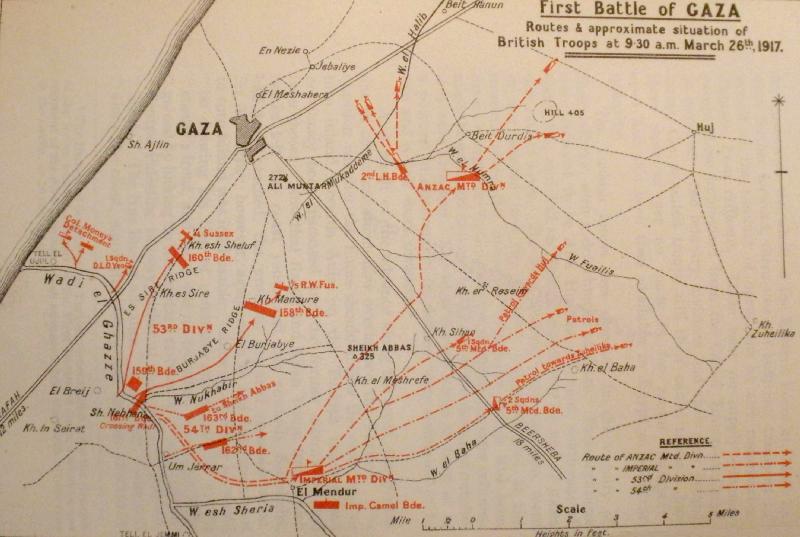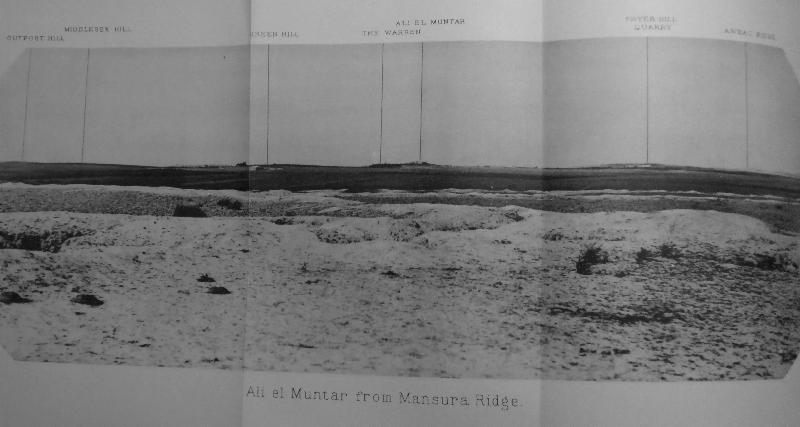Topic: BatzP - 1st Gaza
The First Battle of Gaza
Palestine, 26 to 27 March 1917
Falls Account Part 7
Falls Account, Sketch Map 14.
The following is an extract of the Falls Account from the the Official British War History volumes on Egypt written by Falls, C.; and, MacMunn, G., Military operations: Egypt and Palestine, (London 1928), pp. 279 - 325 detailing the British role at the First Battle of Gaza, Palestine, 26 to 27 March 1917.
Falls, Chapter XVI The First Battle Of Gaza
The First Battle of Gaza.The capture of Ali Muntar.
The 53rd Division had not been in action since the Gallipoli campaign. It had now reached a high standard of training, and the troops, after their winter in Sinai, were thoroughly fit and acclimatized. Its advance up the ridges was a model in precision and steadiness, and the horsemen of the Dominions, who watched it as from an amphitheatre, witnessed a good example of British infantry tradition.
The deployment of the division is shown below, the 160th Brigade being separated from the other two, until approaching Gaza, by the valley between the Es Sire and Burjabye Ridges.Left160th Brigade.2/10 Middx. 1 /4 Sussex. 2/4 Queen's(2/4 W. Kent in Money's Detachment.)
Centre158th Brigade.1/5, 1/6, 1 /7 R.W.F, 1/1 Hereford.
Right159th Brigade.1 /5 Welch, 1 /4 Cheshire, 1 /4 Welch.(1/7 Cheshire divisional reserve.)
The left battalion of the 158th Brigade, the 5/Welch Fusiliers, reached the "cactus garden" south of Ali Muntar, and there halted to allow the other battalions, which had more ground to cover, to come up on its right. The 1/Hereford, from brigade reserve, was brought up to attack Green Hill on the left front, since it enfiladed the advance of both the 158th and 160th Brigades. The 159th Brigade had now come up on the right of the 158th and was directing its advance on Clay Hill. Heavy machine-gun fire met the troops as they approached the position, and the advance slowed down.
By 3.30 p.m. the 161st Brigade had reached Mansura. Assured of a new divisional reserve, General Dallas at once sent the 7/Cheshire to rejoin the 159th Brigade. The Cheshire was moved up in support of the 5/Welch on the left, which appeared to Br.-General Travers to be meeting the stiffest resistance and to have come to a standstill.
The support of the artillery had not been very effective in the early stage, partly owing to its unavoidably hurried entry into the attack. (General Dallas in his report refers to the difficulty in the way of two artillery brigades giving adequate support to three infantry brigades.) The arrival of the 271st Brigade R.F.A. with the 161st Brigade Group produced a marked effect in diminishing the fire of the machine guns on Clay Hill.
At 3.50 p.m. the determination of the infantry earned its reward. Some forty men of the 5/Welch Fusiliers (158th Brigade) and the same number of the 5/Welch (159th Brigade) suddenly dashed forward through the machine-gun fire and made lodgements at two points in the trenches east of Ali Muntar mosque, capturing 20 Germans and Austrians, and 20 Turks. The grip upon the position was held fast with utmost difficulty in face of local counterattacks, but was made secure so soon as the support of the 271st Brigade R.F.A. had checked the galling fire of a nest of machine guns on Clay Hill.
On the left the 160th Brigade had advanced more rapidly. By 1.30 p.m, the Labyrinth, a maze of entrenched gardens due south of Gaza, had been captured, and the 2/10th Middlesex was established on a grassy hill overlooking the town and half a mile from it. The 4/Sussex, advancing up the centre of the Es Sire ridge under intense fire, was less successful. After losing their commanding officer and suffering heavy casualties, the troops fell back in some disorder from the crest. At 4 p.m., reinforced from the reserve and its task made lighter by the success on its left, the battalion again advanced.
It would appear, however, that the infantry had been considerably shaken by the artillery fire which met it, for the 265th Brigade R.F.A. reports that stragglers from the three battalions of the 160th Brigade continued to fall back through the guns till dusk.
As the 158th and 159th Brigades slowly fought their way forward, General Dallas realized that more driving force was necessary if the whole position was to be carried. Machine Guns on Green Hill had delayed the 158th Brigade's advance all the afternoon, and that brigade's reserve battalion, the Herefordshire, which had been put in to attack the hill, had swung away to the right, as so often happens in attacks of this nature. General Dallas ordered the 161st Brigade, leaving one battalion in divisional reserve, to carry Green Hill and fill the gap between the 158th and 160th Brigades. The brigade began its attack at 4 p.m., 1/4th Essex on right, 1/5th on left, 1/6th in brigade reserve, and, despite heavy fire, captured its objective at 5.30 p.m. The 159th Brigade had meanwhile also been successful. The 4/Welch and 4/Cheshire stormed Clay Hill at 4.45 p.m., and the brigade's whole objective was in its hands shortly afterwards.
By 6.30 p.m. the whole position was won, the Turks everywhere running back into Gaza. The 159th Brigade had its right on Clay Hill and its left south of the Gaza - Beersheba road, the 158th Brigade held Ali Muntar, the 161st Brigade Green Hill, and the 160th Brigade was north of the Labyrinth.
So far, then, as the troops were concerned, all seemed over. By nightfall Gaza was surrounded completely, except for its south-western side. Everywhere save among the sand-dunes, where a comparatively small body held its position in front of Money's Detachment, the Turks had fallen back to the town. The British troops, weary but exultant, looked forward with confidence to the surrender of the whole garrison at dawn. Meanwhile they were consolidating the positions won and pushing forward patrols, which felt their way among the houses till in the course of the night men of the A. & N.Z. Mounted Division from the north and east met infantry of the 53rd Division in the eastern streets. Yet, while to them a brilliant victory seemed about to reward their labours and sacrifices, Generals Dobell and Chetwode at In Seirat found cause for anxiety. Though the town was enveloped, the advance of the enemy from north and east boded ill for the morrow.
Falls Account Line of March Picture.
Previous: Falls Account Part 6, The attack on Gaza by the mounted troops and the advance of relieving columns.
Next: Falls Account Part 8, The Decision to Withdraw the Mounted Troops.
Further Reading:
The First Battle of Gaza, Palestine, 26 to 27 March 1917
The First Battle of Gaza, Palestine, 26 to 27 March 1917, Allied Forces, Roll of Honour
The Palestine Campaign, 1917 - 1918
Battles where Australians fought, 1899-1920





